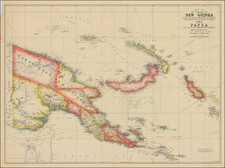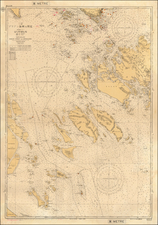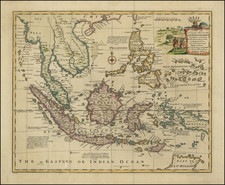A sheet containing two highly important and rare maps of Palembang, Sumatra and the Island of Bangka, from the groundbreaking work of Phillip Franz von Siebold.
This pair of maps is of considerable historical importance for they are the first published maps focusing on Palembang, Sumatra and the Island of Bangka (located nearby) based on scientific surveys, done following the region's subjugation to Dutch colonial rule.
While Sumatra and the surrounding islands had been claimed by the Dutch East India Company (the VOC) since the early 17th-century, in actuality until the early 19th-century the region was controlled by indigenous sultans who maintained a loose tributary relationship with the VOC. Following the Napoleonic Wars, things changed as the Dutch decided to assume more direct control over the Indonesian Archipelago.
The Island of Bangka, located just off of the southeastern coast of Sumatra, had fallen under British suzerainty in 1806. However, the Anglo-Dutch Treaty of 1814 (also known as the Convention of London) transferred the island to Dutch rule. The present map, Het Eiland Banka, is based on the first scientific survey of the island, conducted by Dutch engineers in 1819. This very detailed map charts the island's coast based on trigonometric surveys regulated by astronomical observations. Mountains and rivers are featured, while each of the towns and villages are labeled, along the basic network of roads that traversed the island. Bangka is shown divided into the various districts controlled by local chiefs. Four fine coastal profile views occupy the space in the lower left corner. Importantly, Siebold's map represents the first time that this survey appeared in print.
The second map, De Rivier van Palembang, which occupies the far left of the sheet, depicts the most important city in southern Sumatra and the river connecting it to the South China Sea. Palembang was historically a powerful sultanate that chafed at Dutch interference in its affairs. Made rich by pepper, up to 1819, the sultan was always able to pay tribute to the VOC in return for having his kingdom's autonomy respected. However, that year the new Dutch regime violated the established arrangement by sending a military expedition to Palembang with the aim of subjugating the sultanate to direct Dutch rule. This expedition was repulsed, but was followed in 1821 by a more robust military operation led by General Hendrik Merkus de Kock, which succeeded in its objective. During the expedition Kock's engineers made the first accurate survey of the Palembang river region, which appeared for the first time in print as the present map.
This pair of maps are from Phillip Franz von Siebold's epic study of Indonesia, Japan and Korea, included in the first volume of Nippon. Archiv zur Beschreibung von Japan und dessen Neben- und Schutzländern: jezo mit den südlichen Kurilen, Krafto, Koorai und den Liukiu-Inseln (7 volumes, printed in Leiden, Netherlands, 1832-1852). Highly detailed and profusely illustrated, it was by far the finest and most important European study of the history, ethnography, geography and flora and fauna of much of Indonesia, Japan and Korea published to date.
Phillip Franz von Siebold (1796-1866) was a German physician, who joined the service of the Dutch East India Company (the VOC). Arriving in Batavia (Jakarta) in 1823, he was given privileged access to the map archives of the VOC, including the original manuscript surveys that were the basis for the present maps. He subsequently travelled to Japan, where he acquired groundbreaking sources on the cartography of Japan and Korea.
These maps of Bangka and Palembang are historically important monuments of the introduction of scientific cartography to Indonesia as well as fascinating artifacts recording critical events during which the Netherlands consolidated its control over the archipelago.
These maps are very rare. We are not aware of another example of this map sheet containing Het Eiland Banka and De Rivier van Palembang appearing as a separate sheet on the market during the last 30 years. In 2013, a leading dealer was offering an incomplete set of the books for $100,000 which was lacking more than 500 pages of text and over 30 plates.









![[Straits of Malacca, Sumatra, Java and Western Borneo]](https://storage.googleapis.com/raremaps/img/small/51765.jpg)
![[Sulawesi] Kaart van Zuid West Celebes bevattende deGouvernemts. de Leenroerige en Een Gedeelte der Bondgenootschappelijke Landen behoorende tot het Gouvernements van Celebes en Onderh . . .](https://storage.googleapis.com/raremaps/img/small/51902.jpg)


![(Rare copperplate edition!) Asia Secunda Pars Terrae in Forma Pegasi [Asia in the Form of Pegasus]](https://storage.googleapis.com/raremaps/img/small/82046.jpg)
